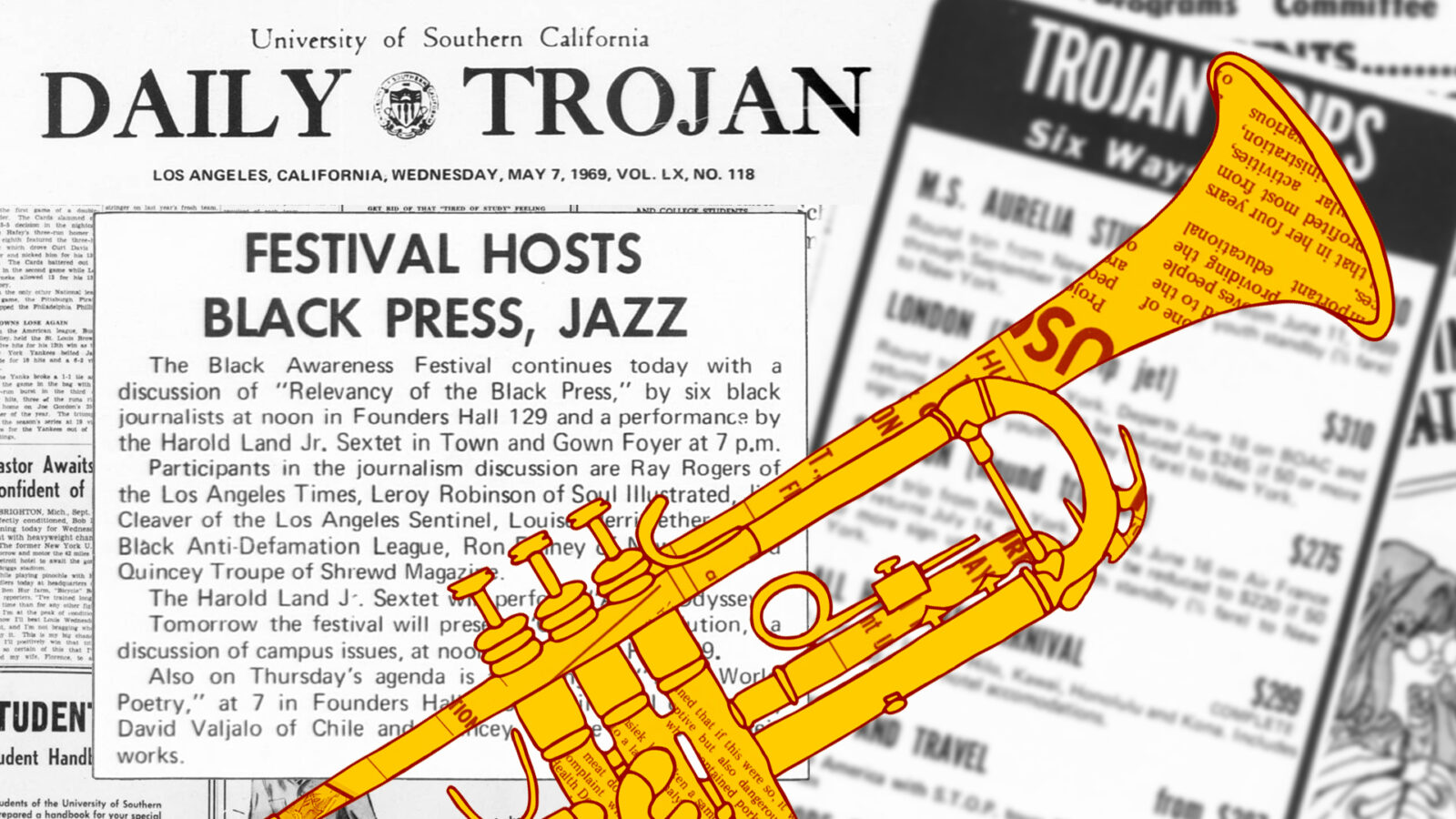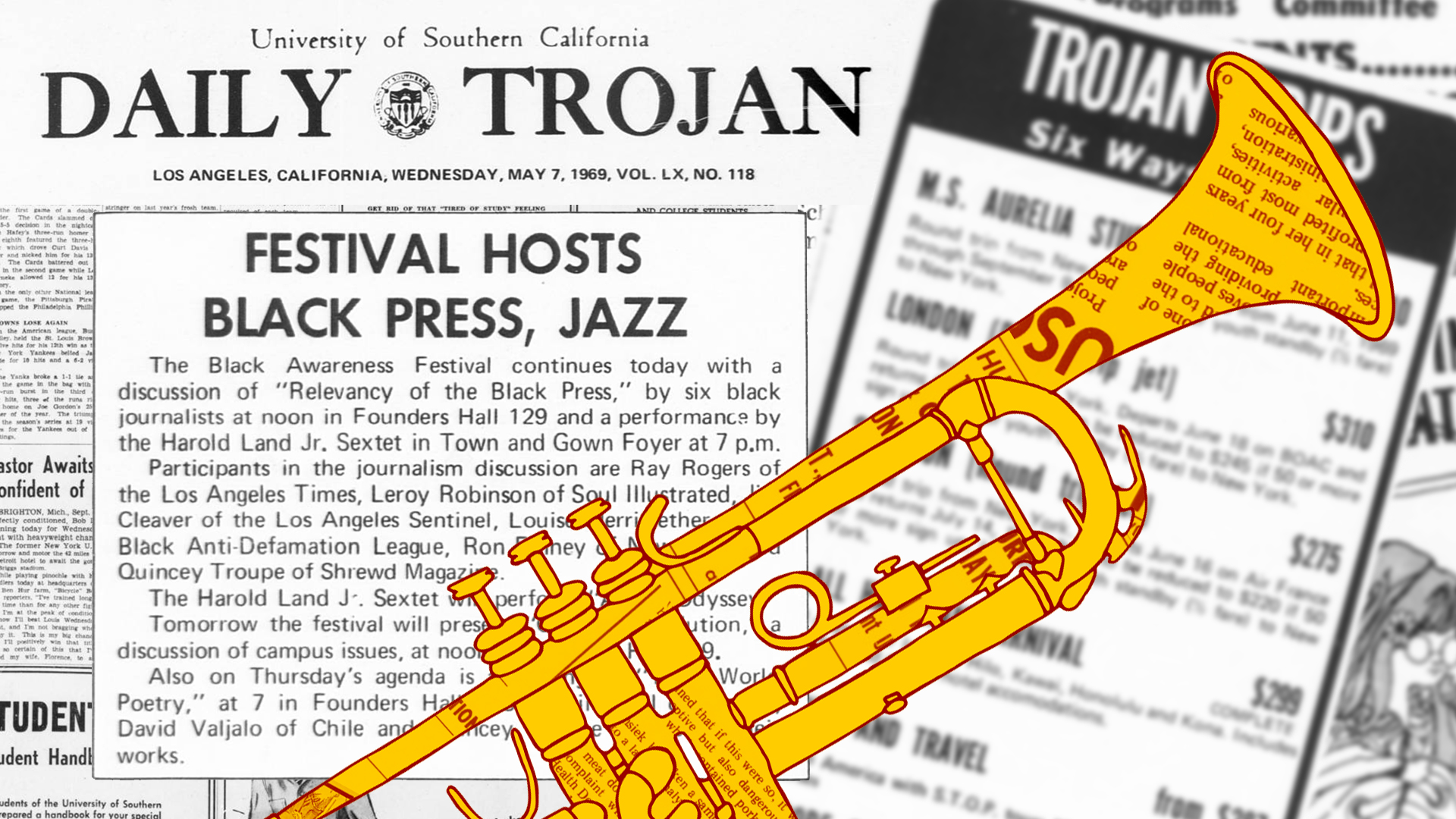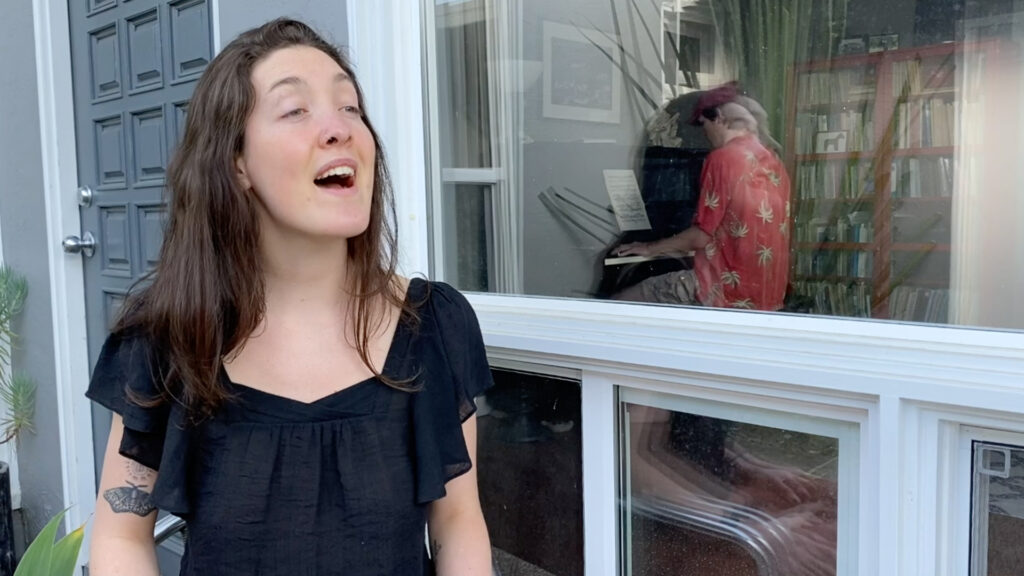
Rhythm Changes
By Julie Riggott

In USC Thornton’s Jazz History class, Daily Trojan archives bring 100 years of history to life.
As Hazle Thunes (BA ’22), an undergraduate in the Jazz Studies program, scanned back issues of the Daily Trojan on the USC Digital Library site, a headline caught her eye: “Festival Hosts Black Press, Jazz.” The brief article, dated Wednesday, May 7, 1969, announced the continuation of a multi-day Black Awareness Festival on campus.
That day’s lineup included a panel discussion about “Relevancy of the Black Press” with six black journalists (representing The Los Angeles Times, Soul Illustrated, Newsweek, the Black Anti-Defamation League, the Los Angeles Sentinel and Shrewd Magazine) in Founders Hall at noon, and a performance by the Harold Land Jr. Sextet in the Town and Gown foyer at 7 p.m.
The following day promised a discussion of campus issues, titled “Campus Revolution.”
And Thursday’s agenda featured a reading of “Third World Poetry,” where Tunji Vidal of Nigeria, David Valjalo of Chile and Quincey Troupe (who represented Shrewd Magazine in the journalism panel and later co-wrote with Miles Davis Miles: The Autobiography) recited their work.

Hazle Thunes (BA ’22), an undergraduate in the Jazz Studies program, scanned back issues of the Daily Trojan on the USC Digital Library site.
The article was a window into life on campus 52 years ago, providing a glimpse of how jazz was a part of that moment in Los Angeles. Thunes thought it spoke to the power the University and its students have to effect change in every generation.
“Knowing this event took place near the end of such a tumultuous decade of fighting for civil rights, I was encouraged to see that USC, a powerful force in education, was providing space for it,” Thunes said. “I learned that USC has welcomed musical expression onto campus for many decades and that this university has the power to create space for underserved communities and provide a platform for creators and the leading voices of every generation.”
Jazz on Campus
Thunes’ research was part of an assignment in Assistant Professor of Musicology Nate Sloan’s USC Jazz History class. He asked students to explore the archives of the Daily Trojan; find an article, advertisement or other item that discusses jazz; and write about how the role of jazz on campus has changed over the years.
“A number of students found articles that testified to the enormous mainstream popularity of jazz from the 1920s to the 1960s,” Sloan said. “If you went across the street to the Shrine, you would find Miles Davis and Stan Getz and Duke Ellington packing the auditorium, selling out the Shrine. That represents a change, because today jazz is popular, but it is not cracking the Top 40 or selling out the Shrine.”
Students discovered that, starting almost 100 years ago, jazz was the soundtrack to fraternity parties and the No. 1 activity on weekends and weeknights. And, as the Black Awareness Festival article demonstrated, “it was also the soundtrack to the civil rights movement and new racial consciousness on campus during the 1960s,” Sloan said. “So, when you look through the history of USC, you find jazz was so often the score for the changing culture around the students. Jazz is a huge part of the story of campus life.”
After the ’60s, things started to change. “Over the last half century,” Sloan said, “there’s been a shift in how jazz relates to mainstream culture, and it’s become more of a rarefied art form. As the decades go on, you see fewer references to jazz in the Daily Trojan, and that reflects the way that jazz has entered the world of art music and departed the world of popular music.”
Jazz Studies major Brian Grabin (BM ’22) found an article from 1959, where the head of the composition program at USC Thornton explained why jazz was inferior to classical music. Then, in 1995, Classical Guitar major Frank Wendelin (BM ’22) found a 1995 article discussing the USC Symphony performing with jazz saxophonist Wayne Shorter.
“You can really trace how jazz was becoming accepted as a serious subject for study on campus, and eventually becomes a hugely important part of the curriculum here at USC,” Sloan said.
USC Thornton launched its Jazz Studies program in 1983. “It was one of the earliest in the country,” Sloan said. “There are only a few other schools that established jazz programs before USC did.”
Music as Cultural Barometer
Sloan’s research and teaching focus on how music — from 1920s jazz to 21st-century pop — reflects people’s experiences, “how music holds up a mirror to society and tells us about people’s hopes and dreams and fears and anxieties.” With songwriter Charlie Harding, he hosts the acclaimed “Switched on Pop” podcast about “the making and meaning of popular music” and published a book with the same name.
“Popular music is,” Sloan said, “almost like a barometer for the national mood. What people are listening to tells you a lot about who they are.”
Sloan likes to make archival work part of his classes, taking advantage of the extensive resources the USC Libraries provide and connecting students to the history they’re studying. “We’re reading a textbook about jazz history, and the descriptions of how jazz was changing in the 1950s are reflected in the Daily Trojan articles the students found. Hands-on archival work turns history from something abstract and remote to something that’s very real and present.”
Andrew Justice, head of the music library at USC Libraries, said, “The Libraries have endeavored to provide the best possible service during the pandemic, including the acquisition of more e-books and databases for research, home delivery for physical items from our collections, and increased digitization services.”
With access to high-quality digitized images of the Daily Trojan, students were immersed in campus life over the decades. They saw what made the front page, the news and entertainment of the day, campus events, op-eds, editorial cartoons, and advertisements.
“I thought it was really interesting to see how the paper has continuously evolved over time,” said jazz pianist Jason Picker (BM ’22), a double major at USC Thornton and the USC Marshall School of Business, who wrote about a 1957 music review poking fun at “a new type of jazz” at a Shrine concert featuring Miles Davis, Dave Brubeck, and Woody Herman. “Back then, the Daily Trojan played a different role on campus.”
“It really puts you directly in a time when jazz was the soundtrack of mainstream America,” Sloan said. “And for me, and I hope for my students, that’s inspiring because it may cause you to ask, ‘How could I make my music relevant and important and compelling to audiences today in the same way that it was in the ’20s, ’30s, ’40s, etcetera?’
“By connecting to this time when jazz was in everyone’s ears and on everyone’s lips, it can encourage you to create your own artistic expression that continues that lineage.”


